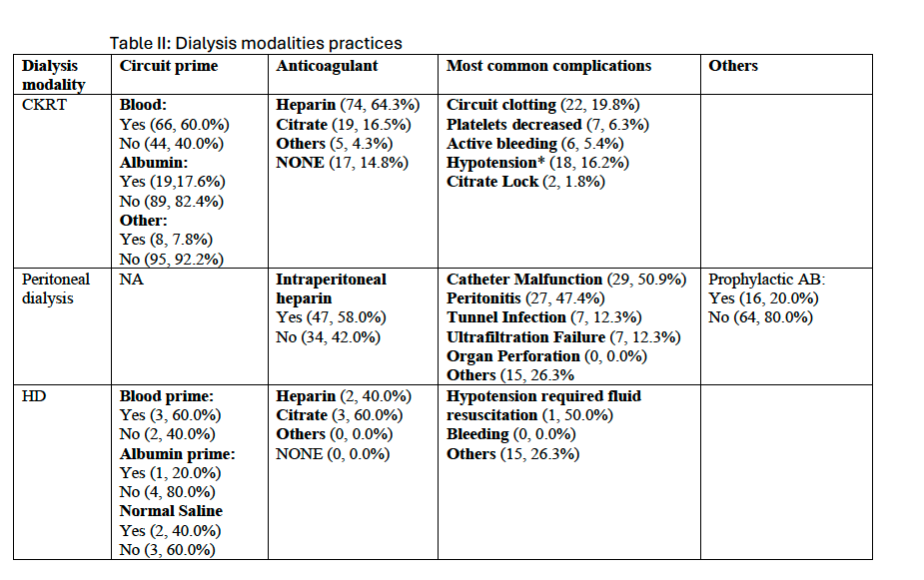Neonatal Nephrology/AKI 2
Session: Neonatal Nephrology/AKI 2
025 - Neonatal & Infant Kidney Replacement Therapies: A Multicenter 5-Year Experience Data from the Neonatal & Infants Kidney Support Therapy (NIKST) Collaborative
Saturday, April 26, 2025
2:30pm - 4:45pm HST
Publication Number: 25.5992
Arwa Nada, Loma Linda University Children's Hospital, Loma Linda, CA, United States; Rebecca Ruebner, Johns Hopkins Children's Center, Baltimore, MD, United States; Megan Gates, UPMC Childrens Hospital of Pittsburgh, Pittsburgh, PA, United States; Mimily Harsono, University of Tennessee Health Science Center College of Medicine, memphis, TN, United States; Ibrahim Sandokji, Taibah University, Madinah, Al Madinah, Saudi Arabia; Hannah Kim, Penn State Children's, Hershey, PA, United States; Ayesa Mian, Golisano Children's Hospital at The University of Rochester Medical Center, Rochester, NY, United States; Haris Rehman, Lake Erie College of Osteopathic Medicine Bradenton, Lexington, MA, United States; Rupesh Raina, Akron children, Brecksville, OH, United States; Weiwen V. Shih, University of Colorado School of Medicine, Aurora, CO, United States; Mark R.. Hanudel, UCLA Mattel Childrens Hospital, Los Angeles, CA, United States; Michael A. Freeman, Penn State Children's Hospital, Hershey, PA, United States; Marissa Defreitas, University of Miami Leonard M. Miller School of Medicine, Miami, FL, United States

Arwa Nada, MD., MSc. (she/her/hers)
Associate Professor
Loma Linda University Children's Hospital
Loma Linda, California, United States
Presenting Author(s)
Background: Advancements in kidney replacement therapies (KRT) have been notable in recent years, particularly since the FDA approval of the Cardio-Renal Pediatric Dialysis Emergency Machine (CARPEDIEM) for infants weighing 2.5 kg to 10 kg in April 2020. However, there remains a lack of data regarding the impact of these new neonatal dialysis modalities on clinical care, the geographical distribution of different KRT modalities, racial and ethnic disparities in KRT usage, common indications for neonatal KRT, elated complications in neonates
Objective: Analyze data on various neonatal dialysis modalities over the past five years .
Design/Methods: This multicenter retrospective chart review encompassed preliminary data from nine centers (eight in the USA and one in Saudi Arabia), including 212 neonates and infants (0 to 6 months of age) admitted to any hospital units who received any form of KRT from January 1, 2018, to December 30, 2022.
Results: Demographic and KRT data are shown in table I.
KRT practices are shown in Table II. Dialysis was primarily ordered by the Pediatric Nephrology team (185 cases, 88.1%), followed by the CVICU/CTICU team (9 cases, 4.3%), NICU team (8 cases, 3.8%), and PICU team (7 cases, 3.3%). One case (0.5%) had an unknown ordering source.
At time of discharge, 80 (44.2) newborn were dead, 51 cases (28.2%), were not receiving dialysis, 46 cases (25.4%) baby were still receiving dialysis (various modalities), 3 cases (1.7%) were transferred to other centers and no data available on one case.
Conclusion(s): This study provides critical insights into the utilization and outcomes of various KRT modalities in neonates and infants over a five-year period, highlighting the prevalence of CKRT use and associated clinical outcomes. The data also underscore racial and ethnic representation and disparities in neonatal KRT. Further studies are needed to refine these findings and explore the long-term impact of KRT advancements on neonatal care and racial and ethnic equality.
Table.1: Demographic Data & Dialysis Modalities
.png) Table.1: Demographic Data & Dialysis Modalities
Table.1: Demographic Data & Dialysis ModalitiesTable II: Dialysis modalities practices
 Table II: Dialysis modalities practices
Table II: Dialysis modalities practices
